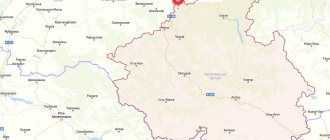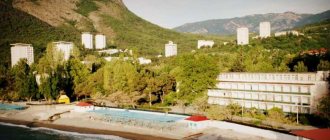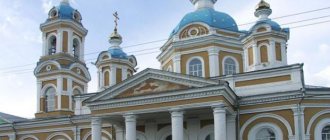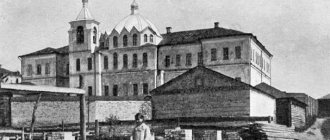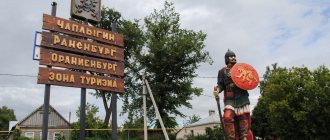At the beginning of May, a draft of a new general plan for Kursk was published by the Giprogor Institute of Urban Planning and Investment Development, designed for implementation until 2040. It was presented to Governor Roman Starovoit on May 25: project manager Olga Enina and chief architect of the project Irina Ratnikova spoke at the event.
“We agreed that we will prepare for the 1000th anniversary of Kursk. As part of this work, we held an architectural competition to develop an architectural concept for the renovation of the historical city center. And before starting the engineering design of these objects, it is necessary to develop and approve urban planning documentation, which, of course, is the urban planning plan of Kursk,” noted Roman Starovoyt.
The project caused controversy among the townspeople, and one of the most problematic issues was the planned road through the dachas and pine forest in the KZTZ area. Due to social tension (or other reasons), public hearings scheduled for the end of May were postponed for a month. As the head of the region reported, during this time the developers must take into account a number of comments. It has not yet been clarified what kind of comments we are talking about.
Everyone was asked to send their comments to the Committee of Architecture and Urban Planning of Kursk: to do this, you need to come to Lenin Street, 69 before June 11 or send them by email
At the same time, Kursk social activists Vladimir Sinelnikov and Oleg Pogozhikh from the Public Control Inspectorate announced their readiness to hold their discussion: last time such an event was dedicated to the fate of the tram. They promise to announce the exact date and time in the coming days.
General plan is a document that sets out the planned state and purpose of the territories of a municipality. It approves the boundaries of the settlement, functional zones and the layout of local facilities.
It is important to highlight two points. Firstly, there are no sanctions in the legislation for failure to implement the intentions laid down in the general plan, so some infrastructure projects may not come to fruition, remaining “on paper”. Secondly, functional zoning in the general plan does not impose requirements and restrictions on land plots, but prepares the ground for the development of an urban zoning map into land use and development rules and urban planning regulations.
Suitable for a rural lifestyle rather than an urban one
At the presentation of the project, Olga Enina thanked the officials for the carte blanche given, noting the lack of pressure and the opportunity to express the institute’s point of view on the city’s development option.
Studying the current state of Kursk, the developers noted the significant extent of the city from north to south and the predominance of individual buildings, “more suitable for a rural lifestyle than for an urban one.” Later, Roman Starovoyt agreed with the observation.
According to Giprogor, due to the shortage of free territories, Kursk is gravitating towards extensive development of the city with the expansion of its borders, and the spotty nature of development only aggravates the situation. The historical appearance, which needs careful attention, “has suffered from chaotic estate development.”
In addition to the historical center, additional points of attraction and public spaces have not been formed in Kursk; there is also an imbalance in the provision of green spaces to different areas.
In response to this, the developers proposed a focus on more compact development within the city and strengthening connections between existing territories. The concept of the general plan, according to Giprogor employees, was based on the development of Kursk without changing the current city boundaries. In the central part of the city, it is planned to increase the density of low- and mid-rise residential buildings in accordance with the previously developed strategy for the socio-economic development of the city.
It was noted that the provision of green spaces to city residents is now four times less than the standard: only 4.2 square meters. m per person with the required 16. To solve this problem, it is proposed to create a system of green spaces, including in residential areas of the city, and implement the concept of a “park city”.
But for the most part, they plan to achieve the goal by including urban forests in the zone of “green spaces” for recreational purposes - including 9 hectares in the area of Entuziastov Avenue and 27 hectares in the Log-3 tract. In order not to formally reduce the number of urban forests, they plan to include the lands of the Krutoy Log tract and areas of environmental significance.
Map of Kursk with houses. Features of architecture and attractions of the city
On the territory of Kursk there are unique buildings dating back to the architecture of the 19th century. History buffs will find many interesting places in the city. Using Kursk routes on the map, you can plan a walk around the city to see all the sights:
- Excellent examples of ancient architecture are the building of the former Assembly of the Nobility, the estate of the merchant Khloponin, and the Treasury House.
- While walking around the city, it is worth visiting the numerous museums. This is a museum of archaeology, local history, literature, zoology, as well as a museum of automobile transport and even a tram.
- On the territory of the city, using a map of Kursk with streets in good quality, you can find the famous Church of the Dormition of the Mother of God and the Great Martyr Nikita.
- The Catholic Church of the Assumption of the Virgin Mary is worth a visit. It was erected in the 19th century. The building was made in the neo-Gothic style.
- There are many theaters in the city. A map of Kursk with streets and houses will help you find the famous puppet theater.
- Lovers of fine art can visit the art gallery. On its territory there are more than eight thousand works of art dating back to the 16th-20th centuries. Also in the museum's collections are a variety of paintings, sculptures, as well as folk and applied arts. A map of Kursk with house numbers will help you find the gallery.
- The Arc de Triomphe is considered an interesting landmark. This complex can be found on Pobedy Avenue. The arch rises to a height of 24 meters. On the adjacent alley there are various types of military equipment.
Road through the forest and SNT
The moment that caused the greatest public outcry was the construction of a highway connecting Plevitskaya Avenue and the Volokno microdistrict. According to the project, it should pass through the forest in the KZTZ microdistrict. The developers explained what they proceeded from when designing the road:
“It was proposed to extend Nadezhda Plevitskaya Avenue to the southern part of the city and connect it with Leninsky Komsomol Avenue. We worked on the routing of this project of citywide importance, because now the city rests on one link, Engels Street. You yourself know that there are traffic jams there during rush hours: for such a city we need a backup. We laid this route where there is a power line route, and there are clearings in the urban forests.”
Based on the explanations of Giprogor employees, deforestation in this area will be minimized, since the road will pass along an already existing clearing.
Despite this, a significant part of Kursk residents are against the new highway: people fear that the highway will destroy the existing ecosystem, deprive them of a place for walking and recreation, and that the forests will be given over to residential development in the future. Those who support the construction of the route note that the problem of connecting different areas has been brewing for a long time, and there are no other options for solving it.
“Somewhere they publish that this is an already approved general plan, that the forest will be cut down. You know my position: I will personally fight for every tree and stand guard around the clock. All sorts of speculations are absolutely premature, I ask you to treat this as such, we need to calmly discuss and look for compromise solutions. Our position is to preserve all the best that Kursk has. If you build, then only in a situation where it is supported by the residents,” noted Roman Starovoyt at the presentation of the draft general plan.
Members of the SNT located along Sumskaya Street are outraged: in addition to the fact that the road is planned to be built through their territory, the garden plots themselves should turn into land for mid-rise residential buildings. Soon they were joined by individual representatives of political parties and businessmen, whose commercial areas are located both next to their dacha plots and on the lands themselves intended for gardening.
As a result, on May 27, a meeting of summer residents with officials of the city committee of architecture and mayor Viktor Karamyshev took place. The latter said that “no issues in urban planning policy will be resolved at the expense of Kursk residents” and shared his suspicions of the exploitation of the issue by certain political forces.
Representatives of SNT “Druzhba”, “Mokva” and “Kommunalnik” said that they have 1,200 plots of land, the owners of which are in despair: people sold apartments, invested in their land, but now they do not understand what will happen to it.
Viktor Karamyshev said that there was no talk of any demolition even in the project. The mayor's office shared two alternative options for the road: the first with access to it through the railway bridge, the second with the reconstruction of Konorev Street.
The project also plans to build other routes: one of them should connect Sadovaya Street and Nizhny Plan Street, passing through the “mound” - a small green “spot” in the city center on the banks of the Kura River.
In total, the developers presented at the presentation the development of six main directions:
It is interesting that the draft of the new general plan does not include the previously controversial road through the Khokhlov Forest, which should connect Sonina Street and the ring at 2nd Novoselovka. According to a number of Krai’s interlocutors, this was one of the reasons for sending the general plan for revision.
Economy and standard of living
The economic situation in the city of Kursk is stable. Agriculture, industry and trade are well developed in the settlement. The economy of Kursk is a diversified complex, where about 15,000 business entities and about 20,000 individual enterprises operate.
Checkpoint of JSC Elektroagregat, Kursk
The most significant part of the economy is energy, accounting for about 32%. Mechanical engineering and metalworking account for 26%, petrochemical and chemical industries account for 14%, food and light industries account for 11%.
The unemployment rate in the city is insignificant, it is about 1% relative to the total population of the city.
The main city-forming enterprise of Kursk is considered to be JSC Elektroagregat, which produces power supplies, portable radios and engines.
No less significant are the following enterprises:
- ;
- JSC "Kurskrezinotekhnika";
- OJSC Pharmstandard Leksredstva;
- ;
- confectionery plant "Konti".
The space industry is currently actively developing in Kursk. The main supplier of all space developments is Southwestern State University. University students are part of a team of leading scientists in the field of design, research and development. Small spacecraft and promising manned space systems are being created on their basis.
Forests
Contrary to the prevailing picture among many, the new road through SNT does not involve cutting down forests for the construction of residential buildings. It is proposed to remove 36 hectares from urban forests in other areas: 16 hectares in the area of Engels Street and 20 hectares for multi-storey housing on Malysheva Street.
Part of the territories of some SNTs is also proposed to be converted into residential, but for individual housing construction and mid-rise buildings. The project differs from the previous general plan by lowering the number of floors: it is proposed to pay much more attention to low- and mid-rise buildings, and the potential number of houses above nine floors is to be reduced. More townhouses, fewer high-rises.
As in the previous (currently valid) general plan, Znamenskaya Grove is intended for a zone of specialized public development.
Public spaces
Giprogor proposes to make Pochtovaya Street pedestrian - from Semenovskaya Street to Radishcheva Street - to create an art space there. It is planned to make Lunacharsky Street another pedestrian street.
It is proposed to leave the area around Dzerzhinsky Street as a shopping and entertainment area, but to create a pedestrian zone. It can start on Gaidar Street, go through Antokolsky Street, Chisty Lane and up to Krivetskaya Street. At the end of the route, on the Krivets River, it is planned to protect the embankment from flooding to create a “craft village” there. Accordingly, the project involves the creation of pedestrian bridges throughout the pedestrian zone.
Cemeteries
At the request of the mayor's office, areas were provided for the expansion of cemeteries. It is proposed to add 22 hectares to the Northern one, and another half a hectare to the Muslim cemetery on Krymskaya Street.
The crematorium, as previously reported, cannot be located within the city due to the kilometer-long security zone: the Kursk region will be considered for it.
It is worth noting that the residents of Kursk, faced with a lack of clarification on the draft general plan and the absence of a “people’s” presentation, study it on their own: for example, in the public “Renovation of the Nightingale Region” an author’s analysis of the project in various areas appeared.
Yan Yezhov
- #General plan
- #SNT
Kursk
Main article: History of Kursk
Kursk was first mentioned in the Life of Theodosius of Pechersk (not earlier than 1032, when the Dnieper left bank came into the possession of Yaroslav the Wise). In this chronicle, Kursk is described as a large city with developed trade and a significant number of inhabitants; was part of Chernigov, then Pereyaslavl and Novgorod-Seversky principalities. The first mention in the Laurentian Chronicle is in 1095. The year 1095 is also considered the year of the founding of the Kursk appanage principality, which existed in the 11th-13th centuries[10].
The first Kursk prince was Izyaslav Vladimirovich, the son of Vladimir Monomakh. Izyaslav built a fortress in Kursk, and from the end of the 11th century it was one of the most powerful outposts on the border of Kievan Rus (the original Kursk fortifications were dismantled in the middle of the 17th century). The discovery of 40 lead seals of the Drogichin type from the mid-12th century[11] indicates the location of a military-administrative center here[12].
In 1185, Prince Vsevolod of Kursk, who also ruled in Trubchevsk, sent a squad against the Polovtsians; This unsuccessful campaign of the Russian princes is described in “The Tale of Igor’s Campaign.” Later, the Kursk people took part in the Battle of Kalka.
In 1238, the city was completely destroyed by the Tatar-Mongols, after which the Kursk principality was actually ruled by the khan's baskak, who bought tribute to the principality from the khan of the Golden Horde. In 1285, Kursk was again ravaged to the ground by Nogai's horde in response to the performance of the Rylsk and Vorgol princes Oleg, together with the Lipetsk prince Svyatoslav, against the Tatar Baskak Akhmet in 1283.
Kursk as part of the Grand Duchy of Lithuania, Russia, Zhemoytka and others
From 1362 (when the Lithuanian prince Olgerd took possession of the city) until the end of the 15th century, Kursk was part of the Grand Duchy of Lithuania, Russia, Zhamoit and others. Like " Kuresk on Tuskor"
“It is mentioned in the chronicle “List of Russian cities far and near” among the cities of Kyiv [13] (since 1362 [14] Kyiv and the territories related to it were part of the Grand Duchy of Lithuania). The Lithuanian city of Kursk is mentioned in the treaty with the Teutonic Order in 1402.
At the end of the 16th and 17th centuries, Kursk was an important defensive point of the Russian state (it became part of it in 1508) on the borders with the Polish-Lithuanian Commonwealth and the Wild Field. There are known mentions of Kursk in the “Book of the Big Drawing” (1517), in the decree of Ivan IV the Terrible (1582; the sovereign ordered the exile of “kromeshniks, rebels, rebels” “to the outlying cities of Sevsk and Kursk”). In the 15th - early 16th centuries, raids by the Crimean Tatars and Nogais led to the desolation of the city.
Only almost a century after the annexation of Kursk to the Russian state, the city arose again in a new place (on two hills, along the right bank of the Tuskori River, at the confluence of the Kura River); The date of the refounding of Kursk is considered to be 1586[15]. In 1596, a new fortress was erected, the garrison of which in 1616 numbered over 1.3 thousand people. At the beginning of the 17th century, Kursk was repeatedly attacked by Polish-Lithuanian troops (in 1612, 1616, 1617, 1634), Crimean Tatars, and Nogais, but the Kursk fortress was never taken. The siege of 1612 and the siege of 1634 were especially difficult. Residents from Orel and other southern Russian cities were resettled to Kursk (in 1678, Kursk already had 2.8 thousand inhabitants). The city developed due to its advantageous geographical position (the shortest route from Moscow to Crimea, the road leading from Kursk to Kyiv). A foundry was organized, and the kvass and salt industries developed. There was active trade (mainly grain) with the Little Russian lands (Gostiny Dvor was built in the mid-17th century).
In 1708, Kursk was assigned to the Kyiv province, in 1727 - to the Belgorod province, and since 1779 it has been the center (main city) of the Kursk governorship (the first governor of Kursk was Field Marshal General P. A. Rumyantsev). In 1785, the year the city Duma was formed, there were 7,590 inhabitants in Kursk. Since 1797, it was the center (provincial city) of the Kursk province (the first governor was S.D. Burnashev). In the 18th century, Kursk became a major trading city and finally lost its border significance. Leather, brick, and lime production developed there, and numerous stone structures were built (shopping arcades, etc.). There was a shipping company in Kursk (it was managed by the governor himself) - merchant ships were sent down the Seim towards Kyiv.
Ilya Repin. "Religious procession in the Kursk province."
The main event of the city was (and is still held) the annual religious procession from the Znamensky Monastery (founded in 1612) to the Korennaya Hermitage, next to which the Korenskaya Fair arose, one of the largest in the country (transferred to Kursk in 1878).
After the great fire that devastated Kursk in 1781, a new general plan of the city was adopted, according to which the central position was to be occupied by shopping arcades (which were erected on the central square, called Red). In 1768, the stone Ilinskaya Church appeared (it was famous for its choir of singers), in 1778 the Sergius-Kazan Cathedral was built in the Baroque style; By 1778, the Trinity-Sergius Cathedral with rich interior decoration was completed.
In 1780, the first school was opened in the city, and in 1783 - a noble school. A men's gymnasium was organized in 1808, and a theological seminary in 1817. A women's gymnasium opened in Kursk only in 1870.
Sergius-Kazan Cathedral. Postcard from the early 20th century
In 1797, a printing house opened in Kursk. Initially, mainly fiction was published. In 1792, a theater appeared in the city (private, the Barsov brothers), on the stage of which Mikhail Shchepkin made his debut in 1805[16].
In the 18th century, Kursk had the following historical districts and settlements:
- Soldatskaya Sloboda;
- Delivery settlement;
- Podyacheskaya Sloboda;
- City settlement;
- Cherkasskaya Sloboda;[17].
- Ochakovskaya Sloboda;
There were also suburban settlements that were not part of the city:
- Streletskaya Sloboda,
- Pushkarnaya Sloboda,
- Cossack settlement,
- Yamskaya Sloboda[17].
In the 19th century, the historical district of Gypsy Hill was formed and built up.
In 1808, Soldatskaya Sloboda, Rassylnaya Sloboda, Gorodovaya Sloboda, Cherkasskaya Sloboda (all 4 on the southern outskirts of the city), Kozhevennaya Sloboda (on the left bank of Tuskari) were included in Kursk.
At the beginning of the 19th century, Kursk was not only a commercial but also an industrial center. In 1846, there were 70 factories and factories in the city. At the beginning of the 19th century, the city already had a hotel (maintained by Colonel Poltoratskaya). In memory of the events of 1812, the Znamensky Cathedral was erected in the city (consecrated in 1826).
City station (Kursk II) on a pre-revolutionary postcard. The building has not survived.
Since the end of 1868, Kursk has been a railway junction (traffic on the Moscow-Kursk railway was opened on September 30, 1868, when Alexander II, returning from Crimea, went from Kursk to Moscow by special train [18]). In 1878, a railway line was diverted from the Kursk station, located in Yamskaya Sloboda (now part of the Kursk Railway District), to the city center, where the city station (Kursk II) was built[19]. At the end of the 19th century, Kursk became an important center of the food industry (flour milling and sugar); in 1883 a candle factory was put into operation (since 1935 a chemical pharmaceutical plant). Urban amenities developed rapidly: the appearance of water supply dates back to 1874, and tram traffic to 1897 (organized by the Belgian Joint Stock Company of the Railway in Kursk (“Tramways de KOURSK”), which also carried out street lighting work). After the redemption reform of 1861, banks began to open in the city - a branch of the International Commercial Bank, a city public bank, and others.
The church on Florovskaya Street (now Radishcheva Street) was built in 1779-1781. Closed and blown up in 1935.
As of 1900, the city of Kursk, due to its location, had a very picturesque view. The mass of greenery, all the coastal slopes of the Tuskori River were occupied by orchards, a relatively small number of factories and factories distinguished it favorably among other provincial cities located in the southern part of central Russia[5].
In 1903, the Kursk Regional History Museum received its first visitors. Soon the first cinemas appeared in Kursk (Illusion, Mirage, Gigant, etc.), a large library with a reading room, two public gardens - Lazarevsky and Livadia, the latter operated a summer theater. In 1896, a Catholic church in the neo-Gothic style was built in the city, restored and again transferred to the Church at the end of the 20th century. In total, at the beginning of the 20th century, there were 21 Orthodox and one Edinoverie churches, a Catholic church, two synagogues, Lutheran churches, male and female monasteries in the city.
"Plan of Kursk, drawn up and executed by Kulzhinsky." “Kursk collection, with a guide to the city of Kursk and a city plan” / ed. N. I. Zlatoverkhovnikova. - Vol. 1. - 1901.
At the beginning of the 20th century, with the dominant role of the food industry (in Kursk there was brewery No. 1, one of the largest in Russia, owned by A.K. Kvilits), other industries also developed; Thus, in the 1900s, 4 sieve-punching workshops appeared in the city (of which the largest was Tikhonov’s workshop, the products of which were sent to the foreign market - to Germany, Austria-Hungary, etc.). Several machine-building enterprises were organized (in 1914 there were 7 of them, one of them was a railway enterprise). Working conditions at Kursk enterprises were difficult, and strikes often broke out (for example, in 1901-1903 workers of Kursk sugar factories went on strike). Kursk workers took part in the general political strike during the revolution of 1905-1907; The strike was organized by Kursk railway workers.
Moskovskaya street (now Lenin street) in Kursk. Beginning of the 20th century.
On November 26 (December 9), 1917, Soviet power was established in the city.
On September 20, 1919, volunteer troops under the command of General Denikin entered the city. On November 19, 1919, Kursk was taken by the Red Army.
In 1932, Yamskaya Sloboda was included in Kursk, and in 1935 a tram was launched into it. In 1936, the territory of the city of Kursk was divided into Leninsky district (left bank of the Kura), Dzerzhinsky district (right bank of the Kura) and Kirovsky district (Yamskaya Sloboda). In 1937, the Stalinsky district (the southern outskirts of the city) was created. In 1939, Kozatskaya Sloboda, Pushkarnaya Sloboda, Streletskaya Sloboda and the outskirts of the village of Ryshkovo (railway station and construction site) became part of Kursk, with Kozatskaya Sloboda in the Dzerzhinsky District, Pushkarnaya Sloboda in the Leninsky District, Streletskaya Sloboda in the Kirovsky District.
The Great Patriotic War
Schematic plan of the city of Kursk in 1941, drawn up for the needs of the German army.
At the beginning of the Great Patriotic War, Kursk was defended not only by the Red Army, but also by the people’s militia. On August 29, 1941, Kursk was subjected to the first bombing by German aircraft. In Kursk, 4 militia regiments and several fighter battalions were formed, which took part in defensive battles.[20] At the beginning of November, German troops approached the city, and on November 1-2 there were defensive battles for the city.; on the night of November 3, Kursk was surrendered to the enemy (according to other sources, on November 4[21]). The city suffered greatly during the fighting during the liberation from the German occupation, which lasted until February 8, 1943, when the city was liberated by the 60th Army under the command of General I. D. Chernyakhovsky; During the occupation, about three thousand residents of the city were shot, almost ten thousand were driven to Germany, over 10 thousand residents of Kursk died of hunger and epidemics. The total material damage from destruction during the occupation and battles for the city amounted to more than 742 million rubles[22].
Liberated by units of the Voronezh Front during the Kharkov offensive operation, carried out from February 2 to March 3, 1943[21].
February 8
liberated Kursk by troops of the 121st Infantry Division (Colonel Bushin, Mikhail Alekseevich), 132nd Infantry Division (Colonel Shkrylev, Timofey Kalinovich), 280th Infantry Division (Colonel Golosov, Dmitry Nikolaevich), 322nd Infantry Division (Lieutenant Colonel Perekalsky, Stepan Nikolaevich), 248th cadet rifle brigade (Colonel Gusev, Ivan Andreevich); 79th Tank Brigade (Lieutenant Colonel Vysotsky, Fedor Prokofievich) of the 60th Army of the Voronezh Front. The last battles in Kursk ended on February 9.
Also memorable is the Battle of Kursk (July 5, 1943 - August 23, 1943, also known as the Battle of Kursk, during which the Red Army stopped the fascist offensive, which they had prepared under the name Operation Citadel (German unternehmen Zitadelle), and, itself, going into offensive, "straightened the Kursk Bulge", liberating the lands on its flanks (including the cities of Orel and Belgorod). The Battle of Kursk, in its scope, the forces and means involved, tension, results and military-political consequences, is one of the key battles Great Patriotic War The Battle of Kursk lasted forty-nine days - from July 5 to August 23, 1943.
During the war, 245 Kursk residents became Heroes of the Soviet Union, 85 became full holders of the Order of Glory of the Second World War.
Post-war period
The restoration of the city's enterprises began already in February 1943; At the same time, the cultural life of the city was revived - a cinema opened on February 19, and a drama theater opened on February 27. On October 6, 1949, the territory became part of the city, and already in 1953 a tram was launched here. By 1950, the city economy was completely restored. On February 24, 1955, the villages of 1st Lamonovo and 2nd Lamonovo, which were previously part of the Ryshkovsky village council of the Streletsky district (now Kursk district), the villages of Dvoretskaya Polyana and 2nd Tsvetovo, which were previously part of the Novo-Poselenovsky village council of Streletsky, were included in Kursk district. On August 17, 1956, the Stalinsky district was renamed the Industrial district, and the Dzerzhinsky district was abolished, its territory was divided between the Industrial and Leninsky districts. On June 12, 1972, the villages of Popovka and Murynovka, which were previously part of the Sapogovsky village council of the Streletsky district, the villages of 1st Nizhneye Gutorovo and 2nd Nizhneye Gutorovo, which were previously part of the Voroshnevsky village council of the Leninsky district, the villages of 3rd Tsvetovo and 4 -e Tsvetovo, which were previously part of the Novo-Poselenovsky village council of the Streletsky district, the western part of the village of Ryshkovo of the Ryshkovsky village council of the Streletsky district.
Back in the 1930s, several large educational institutions appeared in the city: in 1934 - a pedagogical institute (now Kursk State University), in 1935 - a medical institute (now Kursk State Medical University). The development of the system of educational institutions continued in the post-war years: in 1956, the Agricultural Institute began operating (now the Kursk State Agricultural Academy), in 1964 - the Polytechnic Institute (now the Southwestern State University[23]).
Since 1935, Kursk radio amateurs have been able to receive television broadcasts from Moscow. In 1960, the Committee on Radio Broadcasting and Television was formed under the Kursk Regional Executive Committee. The first local television broadcast aired on January 14, 1961.[24]
By a decree of the Presidium of the Supreme Soviet of the USSR dated April 9, 1980, the city of Kursk was awarded the Order of the Patriotic War, I degree, for the courage and fortitude shown by the city’s workers during the Great Patriotic War and for the successes achieved in economic and cultural construction[21].
Until 2010, Kursk had the status of a historical settlement, but by Order of the Ministry of Culture of the Russian Federation dated July 29, 2010 No. 418/339, the city was deprived of this status[25].

